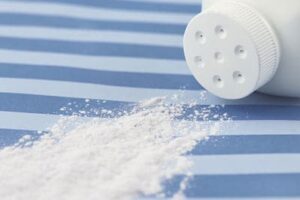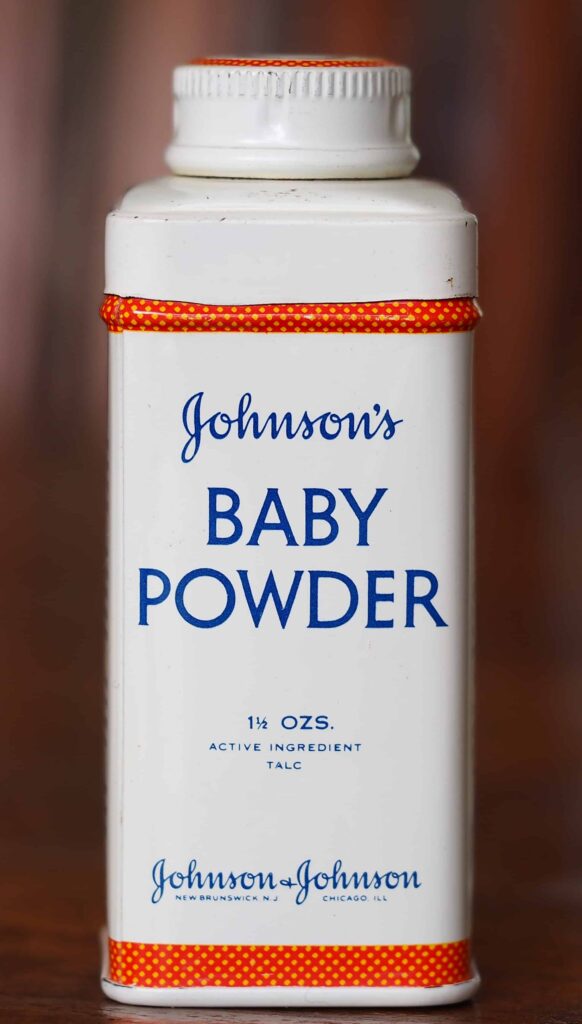 Thousands of lawsuits have been filed across the country by plaintiffs who claim that long-term use of Johnson’s Baby Powder gave them ovarian cancer or mesothelioma. Johnson & Johnson, the product’s manufacturer, has long denied the link between talcum powder and cancer. However, three recent trials and an investigation by the New York Times have produced documentation demonstrating that Johnson & Johnson has been aware for decades that its baby powder had a high risk of containing asbestos, a known cancer-causing substance.
Thousands of lawsuits have been filed across the country by plaintiffs who claim that long-term use of Johnson’s Baby Powder gave them ovarian cancer or mesothelioma. Johnson & Johnson, the product’s manufacturer, has long denied the link between talcum powder and cancer. However, three recent trials and an investigation by the New York Times have produced documentation demonstrating that Johnson & Johnson has been aware for decades that its baby powder had a high risk of containing asbestos, a known cancer-causing substance.
Nearly 12,000 Lawsuits Filed Over Johnson’s Baby Powder
Nearly 12,000 lawsuits have been filed against Johnson & Johnson by plaintiffs who are alleging that they developed cancer from long-term use of Johnson’s Baby Powder. The first such lawsuit was filed in 1997 by a plaintiff who had contracted mesothelioma, though that suit proved unsuccessful.
The vast majority of lawsuits that Johnson & Johnson has faced over its baby powder products have focused on the purported connection between cancer and talc, the key ingredient in talcum powder. So far, the company has largely been successful at defeating these legal challenges, chiefly by arguing that the scientific research linking cancer with talc is flawed and by countering with opposing studies. In total, Johnson & Johnson has lost only six lawsuits that focused solely on the causal relationship between talc and cancer. Of these six losses, three of the decisions were later overturned on appeal, one verdict is still under appeal, and another verdict awarded zero damages to the victorious plaintiff. The sixth verdict, for $110 million, was subsequently upheld by a judge, though Johnson & Johnson continues to contest it in the courts.
Three successful 2018 lawsuits, however, may have reversed that trend, since they have unearthed seemingly damning internal memos from Johnson & Johnson. The most recent such lawsuit was tried over the summer in St. Louis, MO. The jury awarded $4.69 billion to 22 women with ovarian cancer who sued Johnson & Johnson. Their attorney argued that the company knew about a connection between talc and asbestos. This was the third lawsuit to have gone to trial that explicitly alleged that Johnson’s Baby Powder frequently contained the carcinogen. Johnson & Johnson lost two other cases earlier in the year brought by plaintiffs in California and New Jersey with mesothelioma.
According to experts, these cases differ from most of the other talcum powder lawsuits that have been filed against the company because asbestos, unlike talc, is an indisputable carcinogen – and internal memos show that the company knew that its product had a high risk of containing it.
Johnson & Johnson Knew Risk of Asbestos in Baby Powder
As evidenced by documents uncovered by the litigation and research conducted by the New York Times, executives at Johnson & Johnson knew about the presence of asbestos in Johnson’s Baby Powder dating back to the 1970s. Since that era, executives have proposed new testing procedures or replacing talc, while at the same time attempting to discredit research suggesting that the powder could contain asbestos.
In 1971, for example, an executive at Johnson & Johnson wrote in an internal memo that the company’s talc could potentially be contaminated by asbestos, which often appears underground near talc. The executive recommended to senior staff that the company “upgrade” its quality control of talc.
In 1973, another executive argued that Johnson & Johnson should no longer assume that its talc mines were free from asbestos because the powder sometimes contained materials that “might be classified as asbestos fiber.”
“Over My Dead Body”
Johnson & Johnson has also worked behind the scenes to fight independent studies demonstrating the frequent presence of asbestos in Johnson’s Baby Powder. In the early 1970s, as the New York Times discovered, the Food and Drug Administration (FDA) commissioned Seymour Lewin, a New York University chemist, to test talc products. Lewin found asbestos present in more than half of the eleven Johnson’s Baby Powder samples his group tested.
An industry trade group that was given a confidential copy of the report by the FDA shared it with Johnson & Johnson. The group then threatened to sue to block the report from being made public. According to an internal memo, Johnson & Johnson executives asked the FDA to hold the findings in “strict confidence,” arguing that “a release of such untrue information will create a great deal of unwarranted alarm.” An FDA official reportedly told the executives that the report would only be issued “over my dead body.” Johnson & Johnson then asked Walter McCrone, the scientist who usually tested its talc, to visit Lewin and inspect his slides. The company also compiled data and testimonials from other scientists to challenge the results.
Lewin’s final report for the FDA notably differed from what his early findings had suggested. While Lewin had initially stated that the tainted Johnson & Johnson’s talc samples contained two percent or more of asbestos, the final report sent to the FDA claimed that most samples were free of asbestos and that two test results were inconclusive. The government then abandoned a plan to regulate asbestos in talc. Though the cosmetics trade group has adopted a standard of “zero tolerance” for asbestos in talc, adherence is voluntary.
Avoid “Frightening Mothers Unnecessarily”
Johnson & Johnson also reportedly weighed in on independent research again in 1975, when two mineralogists, Arthur Langer at New York’s Mount Sinai Medical Center and Fred Pooley at University College Cardiff in Wales, were collaborating on a study about the asbestos content of powders sold in the United States and England. Pooley had planned to present their findings at an occupational health conference in Britain in September of that year.
However, when Langer revealed that he had found minerals that might be asbestos in samples of Johnson’s Baby Powder, Pooley alerted Johnson & Johnson. Its executives criticized Langer in internal memos as “devious” and argued that his data was “controversial.” Pooley canceled his presentation, and the company pressured him to pull the report from conference materials. Langer continued his research.
In 1976, Langer and colleagues at Mount Sinai told reporters that they had detected asbestos in several commercial talcum powders, though they explicitly said the substance had not been found in Johnson & Johnson products. Johnson & Johnson executives met with Langer and two of his associates days later. The executives told the scientists that they should avoid “frightening mothers unnecessarily,” according to an internal memo.
The memo also noted that “It was pointed out in plain language to the Mt. Sinai group that appropriate correction of their statements should be made to the news media and the public, and that this should be made available by noon of the next day.” In response, the Mount Sinai scientists informed the executives that they actually had found asbestos in Johnson & Johnson’s talc but had not mentioned it because they thought the levels were too low to be of significance.
Eight days later, Mount Sinai’s president, Dr. Thomas C. Chalmers, issued a press release to “correct any misinterpretation or misimpressions the media reports may have generated.” He said that the asbestos tests had been run on older powders, but that the new ones were safe and that Mount Sinai’s pediatricians endorsed the use of baby powder on infants. One of Langer’s colleagues disputed this statement in a 1976 interview with the Washington Post, claiming that the team had tested both new and old powders.
The New York Times noted that Mount Sinai received funds throughout the 1970s from the Robert Wood Johnson Foundation, a national charity established in the early 1970s with $1.2 billion in Johnson & Johnson stock. While the charity was technically independent from the company, several senior Johnson & Johnson executives served on its board.
New Hope for Plaintiffs?
According to the FDA, the agency’s most recent tests of cosmetics, conducted between 2009 and 2010, had found no asbestos present, though the results were “limited” because few products and raw talc samples had been tested.
However, the recent spate of asbestos-related cancer lawsuits against Johnson & Johnson has apparently prompted a rethink in legal strategy by other plaintiffs’ attorneys, who are now considering whether to link their clients’ cancer to asbestos.
“We didn’t even need to know there was asbestos in there to win these cases, but now that we know, it makes it even better,” said Michael J. Miller, a Virginia attorney who represents nine hundred plaintiffs blaming their ovarian cancer on long-term use of Johnson’s Baby Powder. “We’re all eager to get to trial.”
Chicago Talcum Powder Lawyers
If you are a long-term user of talcum powder who has been diagnosed with ovarian cancer or mesothelioma, you may be entitled to seek compensation through a talcum powder lawsuit. If you wish to do so, please consider retaining the services of the Chicago talcum powder lawyers at GWC.
With over $2 billion successfully recovered for our clients and offices throughout the state, GWC is one of the premier Personal Injury and Workers’ Compensation law firms in Illinois.
To schedule a no-cost, no-obligation consultation with one of our attorneys, call our office at (312) 464-1234 or click here to chat with a representative at any time.
<< BACK TO BLOG POSTS